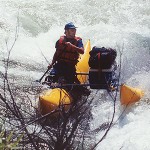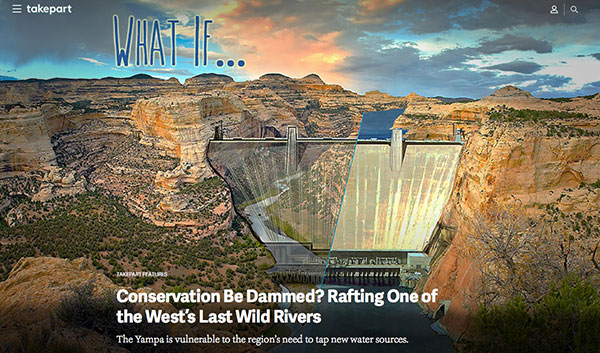Comments Reviews on theboatpeople.com Raft Cataraft Inflatable Kayak Products and Service › Forums › Environmental News › Conservation Be Dammed? Rafting One of the West’s Last Wild Rivers Yampa
Tagged: Yampa River Colorado
- This topic has 0 replies, 1 voice, and was last updated 9 years, 6 months ago by
 Lee Arbach TBP.
Lee Arbach TBP.
-
AuthorPosts
-
January 6, 2016 at 10:17 am #2893
 Lee Arbach TBPKeymaster
Lee Arbach TBPKeymasterConservation Be Dammed? Rafting One of the West’s Last Wild Rivers

One remote stretch of the Yampa River, in Northwest Colorado, inspires fear in even the most veteran boaters. Beneath a forbidding 1,700-foot sandstone cliff, Warm Springs Rapid drops through boulders for about a quarter of a mile, causing a frenzy of violently churning whitewater. In the dwindling sunlight of a late afternoon in June, a group of six raft guides and 21 passengers dotted the shoreline, examining the rapid with quiet solemnity. Furrowing their brows, the guides pointed at the maelstrom and traced a route, hoping to minimize the chance of capsizing. The challenge was to pull against the river’s considerable current, which fiercely sucks boats of all sizes into the maws of the biggest waves.
“If you swim through that one,” said Stefanie Wessel, the lead guide, pointing at one raging recirculating hole, “it would probably push you really deep, and you’d pop out somewhere over there.” She pointed about 50 feet downriver. “You’d be under for maybe six seconds, but it would be a loooong six seconds.” My stomach fluttered. One passenger turned pale. We stared at the river in silence, then walked back to the boats, strapped on our life preservers, and donned our helmets.
“Remember,” said Andrew Corson, a shaggy-haired 26-year-old guide. “Don’t panic!”
It was the third day of a five-day raft trip with the outfitter O.A.R.S. down a 46-mile stretch of the Yampa to its confluence with the Green River in Utah, followed by 26 miles on the Green. According to river guides and experienced rafters, this is one of the country’s best five-day river trips, with scenery that rivals the Grand Canyon’s, a steady string of Class III and IV rapids (out of five; Class VI is essentially a waterfall), and spectacular side canyons with fossils, pictographs, and the detritus of one-and-a-half centuries’ worth of outlaws and cattle rustlers.
I came here to see what a wild river looks like, why one might be worth preserving, and what might be lost if this one were sacrificed to the West’s growing thirst for water. The Yampa holds the distinction of being the last major free-flowing waterway in the Colorado River Basin, the region’s great plumbing system and the most dammed and diverted basin in the country. Without big dams, the Yampa is free to be itself, barreling down the canyon in a brown torrent of snowmelt in springtime and weakening to a trickle in the winter. Because it has so far escaped the drive to dam rivers that consumed the West throughout the 20th century, the Yampa allows endangered fish such as the Colorado pikeminnow—rumored to grow to six feet long—and the humpback chub to thrive. On its banks, the smooth, bare trunks of cottonwoods and expansive sandy beaches tell the story of a river left to rage, unhampered by human meddling. It also acts as a unique laboratory for biologists and a museum for lovers of the outdoors. Many of the Yampa’s contemporary explorers have never before seen a wild river.
Though the Yampa may yet be free, it is nonetheless vulnerable. As the West suffers through one of the worst droughts in 1,200 years, competition for water is heating up. Colorado is developing a statewide water plan, due in December, to resolve a large projected shortage caused by a growing population and a diminishing water supply.
“One of the debates in the water plan is whether the state should support a new project that potentially brings water from the Colorado River Basin to the Front Range” and its big cities, Matt Rice, director of Colorado Basin Programs for the Washington, D.C.–based nonprofit American Rivers, told me before I left for the trip. “Because the Yampa has so much water and it’s this amazing, free-flowing place, it’s going to continue to be a target for large-scale diversions.”
http://www.takepart.com/feature/2015/07/10/yampa-river-rafting
-
This topic was modified 9 years, 6 months ago by
 Lee Arbach TBP.
Lee Arbach TBP.
-
This topic was modified 9 years, 6 months ago by
 Lee Arbach TBP.
Lee Arbach TBP.
-
This topic was modified 9 years, 6 months ago by
-
AuthorPosts
- You must be logged in to reply to this topic.
- Click to share on Facebook (Opens in new window) Facebook
- Click to share on X (Opens in new window) X
- Click to share on LinkedIn (Opens in new window) LinkedIn
- Click to share on Pinterest (Opens in new window) Pinterest
- Click to share on Tumblr (Opens in new window) Tumblr
- Click to share on Reddit (Opens in new window) Reddit
- Click to share on Pocket (Opens in new window) Pocket
